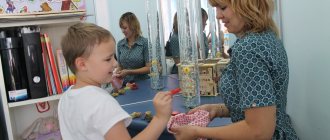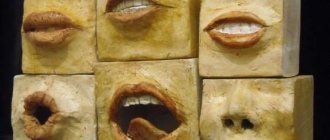Methods for preventing the disease
Due to the biological factors in the development of the disease, it is worth thinking about its prevention during pregnancy and childbirth. Difficult pregnancy, intrauterine infections, asphyxia, complicated childbirth, injuries in the first months of a newborn’s life - all this can cause speech disorders in the future.
We list the main methods of preventing the disease after the birth of the baby.
First, develop your reflexes. These include gaze fixation and object tracking, auditory concentration, motor activity, and the oral automatism reflex - all of them are very important in the development of the newborn.
Secondly, communicate with the baby. Tactile, visual, auditory sensations - all this is extremely important for its development. Smile at him, talk to him, carry him in your arms, stroke him.
Third, be always there. This is especially true for mom. After all, a newborn needs her closeness, the opportunity to touch her, see her, feel her, and receive a return hug.
Fourth, stimulate the sucking reflex. The more actively and longer the baby suckles at the breast, the better its muscles develop - they become stronger and more flexible.
Fifth, encourage the baby's attempts to communicate. Humming and babbling - this needs to be stimulated.
Sixth, develop fine motor skills. Speech is directly related to fine motor skills and the more dexterous the baby’s hands are, the better. Introduce him to different textures.
Seventh, speak to your baby in your native language. Speak clearly and competently. And encourage him to communicate. Even if he doesn't talk, still try to make him make sounds. If he wants something and shows it with gestures, provoke him to ask for it verbally.
A set of breathing exercises
Includes 2 exercises. Parents can easily do them with their baby at home.
"Racing" . Place two cotton balls on the table. The parent blows on one balloon, the child on the other. The one who moves his ball the greatest distance wins.
"Magic Breath" . Insert pieces of cotton wool into the baby's nostrils. The main thing is not deep! Ask him to exhale and at the same time hold the cotton wool - it should not fall out.
Another version of breathing exercises is according to A.N. Strelnikova. The essence of gymnastics is to take a sharp breath through your nose every second and do the exercises at the same time. The inhalation is noisy and strong, and the exhalation is natural, imperceptible.
There are several rules: with each inhalation, lower your shoulders and close your nostrils tightly, as if someone is pressing on them.
Gymnastics should be a joy, so you need to do it until the first signs of fatigue. There is no need to force your child if he does not want to study.
Gymnastics is designed for adults, so the duration of the lesson and the number of approaches is best agreed upon with a speech therapist.
How to make correct pronunciation automatic
Staging and automating the “L” sound at home can be very difficult. This is a long process, so it is better not to overload the child - it is enough to practice for a few minutes 2 times a day (no longer than half an hour). It is better to conduct training in a playful way.
Soft "L"
Even if a child has learned to say the sound “L” itself, as well as syllables with its participation, he can still miss it in words. Then it’s better to start by training the soft sound “L”. Here, too, you should start training with syllables - La, Liu, Li and other similar ones. When the syllables begin to come out, you can try to move on to words:
- Le: light;
- A: fields;
- Le: laziness;
- Liu: buttercup;
- Lee: fox.
The production of the sound “L” in individual words can be reinforced with pure phrases:
- La-la-la - cold earth.
- Lu-lu-lu - I’ll light the stove.
- Li-li-li - we found mushrooms.
Tongue twisters will also come in handy. For example, to make the sound “L” you can use the following:
- Lala ate halva under the blanket.
- Tolya is weaving bast shoes at the warm stove.
- Lyuba loves buttercups, and Polya loves cartoons.
- Lena barely ate; she didn’t want to eat out of laziness.
- Valenka's felt boots are too small for the giant.
If in direct type syllables the articulation of the soft “l” sound begins to be obtained, you can move on to reverse ones. The syllables pronounced are: Al, El, Ol, Yal, Ul, etc. After pronouncing them, you can move on to the corresponding words - for example, tulle, poplar, moth, tulip, stool.
Sound combinations can be complicated by adding additional consonants - K, P, F, G, S (Slyu, Slya, Sli, etc.). It’s not difficult to find words for making such sounds - plum, cranberry, slush, glucose, gumboil, mica, plus and others).
The following exercises for setting L will help you consolidate the skill:
- EL-EL-EL: there are drops in the yard.
- OL-OL-OL: the moth flew.
- EUL-EUL-EUL: quickly lather your palm.
- UL-UL-UL: we will hang tulle.
You can play this game. Connect objects with squares depending on where the letter “l” appears (at the beginning, at the end or in the middle). Talk through each item several times.
At this stage, you still need to monitor the correct position of the tongue in the mouth.
Gymnastics for making sounds
Finger games must be included in the correction program for dysarthria. They can be done at home with your parents. For example, these:
- Reading book “Finger Boy, Where Have You Been?” The child opens his palm and, for each line of the rhyme, touches each finger with his thumb - index, middle, ring and little fingers.
- "We depict animals." This is an analogue of the “Shadow Theatre”. The kid opens his palm, sticks his thumb up - imitates a dog. Raises and lowers the little finger - the dog barks. And if you press your ring and little fingers with your thumb to your palm, and raise your middle and index fingers up, you will get a bunny that moves its ears.
- Hand massage. The technique depends on the tone of the hands.
If you have spasticity, you need to relax: stroke your arms: from your fingertips up to your palms and to your shoulders. Then repeat the movement from top to bottom.
When hypotonicity occurs, muscles need to be strengthened. To do this, parents actively knead and rub their fingers and palms. Stimulating movements.
A set of articulation exercises
The exercise includes 5 exercises and can also be done at home.
“Horse” - clicking the tongue. This is a very useful and effective exercise. Not all children get it right away.
“Pancakes” - the baby opens his mouth slightly, spreads his tongue into a flat pancake.
“Snake” - the child imitates the sting of a snake - the tongue is just as sharp. Then he sticks it back and forth.
“Tube” - the baby tries to roll his tongue into a tube.
Another exercise is to try to reach the tip of your tongue to your nose and then to your chin.
Methods for diagnosing dysarthria
Dysarthria is usually preceded by a primary neurological disease, such as cerebral palsy. Therefore, before starting classes with a speech therapist, you need to consult a neurologist. Only he can diagnose the disease.
Diagnosis includes electroencephalography, MRI of the brain, electroneurography or other examinations. After this, the neurologist refers the patient to a speech therapist. In turn, the specialist, based on speech therapy tests, will determine the form and degree of the speech disorder.
Complex treatment of the disease
Only an integrated approach gives good results. Here are the activities included in treatment:
- Speech therapy classes: development of fine motor skills of the hands, breathing, motor skills of the speech apparatus, voice (timbre, intonation, strength), training in correct sound pronunciation;
- Physiotherapeutic procedures: physical therapy, massage, acupressure, etc.;
- Drug treatment. Nootropic drugs are prescribed;
- Psychotherapy. This group includes sand therapy, play therapy, and isotherapy.
If parents notice speech impairments in time and seek help from doctors, the baby has every chance of getting rid of the disease. But provided that there are no pronounced lesions of the nervous system.
Normal articulation of vowels
Normal articulation of vowels has common characteristics: the soft palate is located at the top and pressed against the back wall of the pharynx. As a result, the passage into the nasal cavity is closed, and the air stream is directed through the mouth. In this case, the vocal folds are in a tense state, they are brought together and vibrate, as a result of which a voice is formed.
- U:
- The lips are pulled forward like a tube.
- The teeth of the upper and lower rows do not touch; they are completely covered by the lips.
- The root of the tongue is retracted back deep into the oral cavity. The back of the organ is raised high to the palate.
- ABOUT:
- The lips are slightly extended forward and take on a rounded shape, but less than in the case of the U phoneme.
- The teeth are covered with lips.
- The tongue is pulled back: the back of its back rises in a lump towards the soft palate.
- A:
- The lower jaw is lowered; a distance of approximately 2 fingers (1-1.5 cm) is maintained between the incisors of the upper and lower jaws.
- The front teeth are slightly visible.
- The tongue is wide, flat, located at the lower teeth, its tip touches the lower teeth, the lateral edges are lowered to the lower chewing teeth.
- AND:
- The mouth is stretched so that it resembles a smile.
- Teeth slightly exposed.
- The tongue moves forward and upward.
- E:
- The mouth is stretched in a smile, but the opening is wider than when pronouncing the phoneme I.
- Teeth exposed.
- The tip of the tongue touches the lower incisors, the sides touch the upper molars, the back is raised, close to the hard palate.
- S:
- The lips are open freely.
- There is a gap between the incisors, which is much wider than when pronouncing the phoneme I.
- The tip of the tongue is strongly retracted, and the back of the organ is raised towards the palate, but does not touch it.











